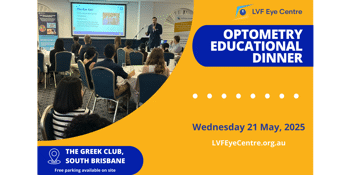
2025 Optometry Educational Dinner (May)
Topic: Advances in patient comfort and refractive outcomes in cataract surgery: drop-free cataract surgery, needle-less sublingual sedation, office-based intraocular surgery, and photopsia-free multifocal IOLs
Recent innovations in cataract surgery have significantly enhanced patient experience and refractive precision. This presentation reviews four technical advances currently shaping modern ophthalmic practice.
Drop-free cataract surgery employs intracameral delivery of antibiotics (e.g., cefuroxime or moxifloxacin) and sustained-release corticosteroids (such as triamcinolone or dexamethasone suspension), substantially reducing the patient compliance burden and eliminating variability associated with topical therapy. This approach enhances postoperative comfort, decreases inflammation, minimizes cystoid macular oedema risk, and reduces infection rates by ensuring therapeutic drug concentrations at target tissues.
Sublingual sedation, utilizing agents such as midazolam or sufentanil administered beneath the tongue, provides rapid, predictable anxiolysis and analgesia without intravenous access. This technique simplifies patient preparation, maintains intraoperative cooperation, and facilitates efficient surgical throughput, particularly beneficial in high-volume settings.
Office-based intraocular surgery leverages advancements in microsurgical instrumentation, infection control standards, and anesthesia to enable procedures in outpatient clinical environments. This model maintains equivalent safety outcomes compared with traditional day-surgery facilities, reduces costs, and offers increased patient convenience and scheduling flexibility, representing a significant shift in surgical practice logistics.
Lastly, recent multifocal intraocular lens (IOL) designs address longstanding patient dissatisfaction related to photic phenomena (halos, glare, dysphotopsias). Advanced lenses utilizing refined diffractive optics, increased intermediate-focus capability, and innovative optical profiles significantly mitigate photopsia, optimizing neural adaptation and delivering high-quality visual acuity across distance, intermediate, and near vision.
Integrating these advances into ophthalmic practice enhances refractive predictability, patient satisfaction, and operational efficiency. Optometrists collaborating closely with ophthalmologists adopting these innovations can expect superior clinical outcomes and enhanced patient care continuity.
Our Presenter – Professor Christopher Layton:
Professor Christopher Layton (Dr Chris) is a private Clinical Ophthalmologist, Rhodes Scholar and a national leader in innovative ophthalmology. His expertise is in macular disease, lens surgery and minimally invasive glaucoma interventions. He completed optometry at QUT, ophthalmology in Queensland, Oxford and London, subspecialty training in retinal disease at the Royal Brisbane Hospital and holds a PhD in diabetic retinopathy from Oxford University. Professor Layton is the founding director of the LVF Ophthalmology Research Centre. He is also CEO of Ocugene, a Queensland based biotech start-up which is commercialising his gene therapy technology targeting macular degeneration, uveitis and choroidal melanoma.